Greetings!
This week’s offering is a trifle late due to me having been on trade union duties down in Wellingborough and then exploring a little of East Anglia with my friend Paul. There should be a little of the latter in the form of a V-log appearing on this site soon if, (and this is a big ‘if’), I can get the technology to work. In the meantime though, here is the second part of my St. David’s Pilgrimage, detailing my travels after I left St. David’s and headed for the Welsh capital and the famous Cwm Rhondda.
Keep travelling!
Uncle Travelling Matt
Links to accounts of all my pilgrimages:
Pilgrimages: To the Holy Island
Pilgrimages: Nazareth in Norfolk
Pilgrimages: And Those Feet Did...
Pilgrimages: The Sacred Heart of Wales
Pilgrimage done, (well, the main part of it at least), I read a short book on St. David and Dewisland, (the area around the city), before catching the bus back to Fishguard where I headed straight for the bath and then ceremoniously shaved off the beard that I’d been growing for the past month and had been irritating me for the past three weeks. Pilgrims have beards and by shaving it off, I wanted to signify that my sacred goal had been completed and indeed, it seemed to affected me mentally as well, for by then I was feeling maxed out on both faith and physical exercise so I retired to bed to recuperate and read Jan Morris’ ‘Wales: Epic Views of a Small Country’, (relevant reading perhaps, but far more secular), before then going drinking. For a small place, it had some cracking pubs, particularly the Fishguard Arms, a tiny place where they served Bass direct from the barrel, and then the Royal Oak, the town’s central pub with a musket from the 1797 invasion mounted on the wall, where I met Steve and we had another good chat. There was a folk band on as well, and although their music was distinctly English, (indeed, all of Fishguard seemed to have more of an English than a Welsh aura), I enjoyed it and I got chatting to another local, a retired teacher who was good company indeed. I was pleased, for pilgrimage is surely just as much about the people as it is about the places, from long dead saints to living bikers, pensioners and monumental masons, and although none of the tales that I heard that night were as riotous as the Miller’s Tale, they were good stories nonetheless and well worth staying up for.
 The Royal Oak, Fishguard: a good place for a pilgrim
The Royal Oak, Fishguard: a good place for a pilgrim
My pilgrimage was done and my face clean-shaven to prove it, but my Rail Rover ticket was still very much valid, with three of the four days left to enjoy and so instead of heading straight home as I usually do, I travelled east to spend a couple of nights in Cardiff for I’d never visited the Welsh capital before. I took the early train from Fishguard, enjoying the views over the Tywi Estuary to Laugharne where I’d visited as a boy on a family holiday, (my mum being a great admirer of Dylan Thomas’ ‘Under Milk Wood’), whilst listening to an Ian Holloway lookalike on the seat in front of me expound on rugby matters to his mate. I carried on reading ‘Wales: Epic Views of a Small Country’ as we rumbled through numerous towns well known from rugby league tables: Llanelli, Swansea, Port Talbot, Bridgend and then Cardiff itself, the book proving to be brilliantly-written and exceptionally interesting. In the capital itself, I walked out of the bustling confines of Central Station and then made my way to my pre-booked guesthouse on the banks of the River Taff and overlooking what many a Welshman regards as the holiest site in his country: the majestic Millennium Stadium.
An account of a pilgrimage is not the place to discuss more mundane, secular sightseeing, although there is considerable crossover between the two in both directions. Suffice to say, I enjoyed myself immensely in the Welsh capital, heading down to the revitalised Tiger bay where I took tea in the Norwegian Church, (where my childhood hero Roald Dahl was christened), strolling the streets, marvelling at the Victorian Gothic fantasy castle and wondering at the exhibits in the National Museum. Whilst sojourning in Cardiff however, there is one encounter which sticks in my mind where the secular was blown aside by the sacred for a few minutes.
Walking through the busy city streets thronged with shoppers, I came across a young man brandishing a copy of the Bhagavad-Gita. Now normally I avoid people who are about to accost you whether their reasons be sacred or secular, but this time I made a beeline for the proselytiser.
“Excuse me mate, is that the Gita?”
“Erm… yes, yes it is.”
“So you are from the Hare Krishnas, right?”
“Yes, yes I am.”
“Excellent! Now, the thing is, I went to your restaurant in Swansea, I forget the name…”
“Govinda’s.”
“Yeah, Govinda’s, that’s the one. Anyway, I was rather impressed and what’s more, I’ve heard that you’ve also got one here in Cardiff and so I was wondering if you could tell me where it is?”
“We did have one, but unfortunately you’re a week too late; it’s just closed down. Are you a vegetarian and have you read the Gita?”
Which launched us into a discussion on vegetarianism, the Bhagavad-Gita and the Hare Krishna movement. Back in Swansea I’d wondered as to what might be so tempting about a spiritual path which is so culturally alien to that of our islands, and here was my chance to find out first hand and after a while what I learnt was that this young man’s path was very much focussed on meditation and what you eat – or to be more precise, don’t eat – and how the latter can affect the former. And the Hare Krishna movement it transpires, is big on both. He went into raptures about how one can cleanse the body by cutting out various foods, (most of them my favourites), and he was most disappointed to discover that my (temporary) vegetarianism was more as a trial, an ordeal to get through so that I could mark this period as holy and then enjoy my kebab meat and jerk chicken all the more when I could eat them again. “If I gave it up permanently then after a while I wouldn’t miss them so much and there’d be no way of marking festivals as well as periods of anticipation,” I explained.
“Oh no,” he countered, “you could give up more! Once a week I now give up eggs and dairy products too! It’s tough but worth it.”
I was tempted ask him what his idea of a party was but thought it might be rude so instead I changed tack and broached a spiritual issue that had been bothering me for some time.
“I have a friend who does daily meditations and east everything except garlic. That struck me as rather weird since normally, if you’re going to give something up, then it’s something that’s really bad for you, (e.g. donner meat, steak pies, cheeseburgers and all the other tasty things that I should be abstaining from permanently), rather than one of the healthiest – and tastiest – things on the menu. This puzzled me so much that I asked him why he did it and he explained that it was to do with the meditation. Apparently, this meditation is a process whereupon one session builds upon the next, rather like climbing a ladder to Nirvana, but if you eat garlic then it knocks you off that ladder and brings you back down to zero. Now, that sounds like utter twonk to me, but to be fair, this is a subject which I know next-to-nothing about and so I ask you, as a man who both meditates and cuts out all manner of pollutant foods from your diet, what do you make of it all?”
He looked at me and then considered the matter for a few moments. Then he asked, “Does he still eat meat?” I thought back to my friend’s last visit to Stoke and him enthusiastically tucking into a Full English Breakfast at ‘Kaptain Kook’s’. “Yep, he eats meat,” I replied.
“Well then, I can’t see what he’s trying to do. Garlic is a food that can affect meditation it’s true, but the effect is so slight as to be almost negligible; certainly compared with the effects of eating meat it’s nothing. If he still eats meat then I’m afraid he’s totally wasting his time. He must have some strange teachers.”
Completely wasting his time, strange teachers. Oh dear, oh dear! Should I tell him? Perhaps I should so that he knows, or then again perhaps he’d be upset? Or worse still, would he start cutting out more than just garlic instead? Now that would be a problem; no more trips to ‘Kaptain Kook’s’ when he comes round! No, thinking about it, I’ll keep my mouth shut…
In the afternoon, as the winter sun was setting, I took a bus up to Llandaff for Holy Communion. Although the capital of Wales today, Cardiff was only designated as such as late as 1955 and prior to the 19th century she’d been no more than a village clustered around the Norman castle. Back in the time of the saints, the ecclesiastical – and thus political – capital of the south had been Llandaff, seat of one of the country’s four cathedrals.
Today Llandaff is a genteel suburb of its younger, upstart neighbour, but the similarities with St. David’s are immediate, for the mediaeval cathedral is hidden in a hollow here too, doubtless to guard it from the malicious gaze of any passing Vikings.
Artistically and architecturally, Llandaff Cathedral is no wonder. Heavily “restored” by the Victorians and then damaged by Nazi bombing during World War II, there is far less of the original cathedral left than most of our other great Gothic cathedrals, but aside from a hideous concrete arch topped by an equally distasteful Christ,[1] these rebuildings don’t detract too much. Besides, the pilgrim is there for other reasons and Llandaff Cathedral is also home to the shrines of two saints: St. Teilo and St. Dubricius.
Teilo was born around 480 near to Tenby and early in his life he became firm friends with St. David and as a young man the two of them, along with St. Padarn, travelled to Holy Sepulchre in Jerusalem on pilgrimage. Upon his returned he ministered at Llandaff (lit. the church on the River Taff), until the plague broke out there, when he led his people to safety across the sea to Cornwall and thence Brittany before returning many years later after the danger had passed.
Dubricius[2] was the illegitimate son of Efrddyl, the daughter of King Peibio Clafrog of Ergyng, a kingdom on the present-day Welsh borders. His grandfather threw his mother into the River Wye when he discovered she was pregnant, but was unsuccessful in drowning her. He and his mother were reconciled with Peibio when the child Dubricius touched him and cured him of his leprosy. Later in life he founded several monasteries and became a great teacher, instructing Teilo who is now buried near him. He became the first Bishop of Ergyng, a position which later became the Bishop of Llandaff and a position which he resigned in order for St. David to take over whilst he retired to Bardsey Island where he died, his remains brought back to the cathedral which he founded. Thus it was, that by praying with and learning about these two great saints, more pieces of the Welsh spiritual jigsaw fell into place for me.
Icons of Sts. Teilo and Dubricius
After praying at both tombs, I attended Holy Communion. There were only three celebrants in the side chapel that evening, a sight that must have saddened those two saints buried close by who worked so tirelessly to bring the Gospel to the people of Llandaff, but it was a beautiful service and receiving the Host felt good after a period of intense religious reflection. Furthermore, after the service was complete, there was the opportunity to ask the clergy present about an idea that had been forming in my mind.
As part of the generally secular book on Wales by Jan Morris that I had been reading since Fishguard, there’d been a chapter on the spiritual side of the country which had, naturally, interested me considerably. And in that chapter Morris had talked at some length about holy wells, something that I had first hand experience of after quenching my thirst at the well beside the ruins of St. Non’s Chapel. Morris talked in some detail and with some enthusiasm about one well, Mair Sant[3] in the Rhondda Valley which had been the focus of much devotion in years gone by – essentially the Number 1 pilgrimage destination in South-West Wales – but was largely forgotten and neglected these days save by the local Roman Catholic community, so that when she visited, it all looked sadly overgrown. Her book though, was written in the 1970s; was it possible to visit Mair Sant now? Had its status and condition improved in the light of the recent revival in the concept of pilgrimage or was it still forlorn and forgotten? The clergy at Llandaff had heard of it, and yes, it was visited by many Catholics and a few Anglicans although they themselves had never been. Thus it was decided: with God’s blessing I would be heading up the Rhondda.
This impromptu second pilgrimage was to be, in many ways, a double pilgrimage for me, a homage to both my sacred and secular sides. For ever since I attained adulthood, two great philosophies have guided my thoughts, words and deeds: Christianity and Socialism.
Now I do not consider the two to be exclusive, but at the same time, I do appreciate that there are some differences. In fact, in many ways it was the socialism that brought me to the Christianity. From an early age I noticed that the world was unequal and unfair, that some people enjoyed great riches whilst others were poor and that upset me greatly. Worse still, as I grew I realised that those with more were constantly trying to gain even more on top of that whilst at the same time denying those with less than them. Now it is not long before anyone who sees the world in such a way becomes a socialist of some shade or another, but to me it is equally natural that such a person will, sooner or later, also turn to the figure of Christ who preached equality before God, the innate dignity of every single human being as a creation of that God and a Gospel based on helping others, friend or foe, rather than helping yourself. Or, as Woody Guthrie so eloquently put it:
‘Jesus Christ was a man who travelled through the land
A hard-working man and brave
He said to the rich, “Give your money to the poor,”
But they laid Jesus Christ in His grave’[4]
And for any British socialist, the Welsh Valleys have meaning. Working class coal mining communities who fought under Thatcher, suffered through strike and disasters and had their children murdered through the negligence of the cost-cutting pit owners at Aberfan. They were fervent socialists all along, electing the first socialist MP (Kier Hardie), rising under Chartism and, most symbolically of all, in Merthyr Tydfil at the end of the Taff Valley, in 1831 the working folk rose up in rebellion and for the first time in world history, marched under a red flag.
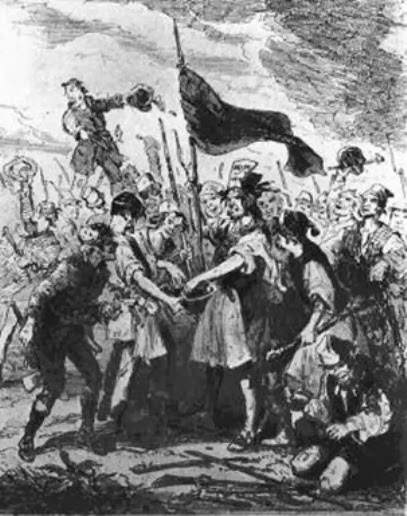 The Peoples’ Flag is deepest red: The Merthyr Rising of 1831
The Peoples’ Flag is deepest red: The Merthyr Rising of 1831
Enquiries at the tourist information centre revealed that Mair Sant lay at a place called Penrhys, a “ council estate situated high on the hilltop above the confluence of Rhondda Fach and Rhondda Fawr (Little Rhondda and Big Rhondda), and was best reached by taking a bus to Tylorstown in Rhondda Fach.
As we wound our way through the drizzle-doused roads of the Valleys, I was reminded of something most unexpected: my favourite Japanese anime film ‘Laputa: Castle in the Sky’. It might sound strange to link an animated children’s adventure from the other side of the world to a Welsh valley, but the connection, I later learnt, is a close one. The director, Hayao Miyazaki, visited the Welsh Valleys in 1984 and witnessed the Miners’ Strike and was so affected that he returned in 1986 to prepare for the film, and the landscape of the Valleys together with the striking miners, (who Miyazaki referred to as a “dying breed of fighting men”), inspired the opening third of ‘Laputa’.
The distance from Tylorstown to Penrhys did not look far on the map, but I hadn’t noticed all those contour lines. The climb, through the steepest terraced streets that I’ve ever encountered, was excruciating but at least the incessant drizzle kept me cool. On the top it was windswept, the “rough” estate of Penrhys to my right and to my left a bare hillside with fantastic views over the Rhondda. On that hillside, occupying the space where once the shrine church stood, was a statue of Our Lady with child which was erected in 1953 with over twenty thousand making the pilgrimage to view the unveiling. The statue signified that the well could not be far away, although finding it was easier said than done and it was only after some wandering through the unkempt grass that I located it, an ancient stone structure on the hillside below the statue, hidden from sight. It was surrounded by a fence and the gate was locked, but where there are rough estates, there are often holes in fences and so I squeezed through this one and sat in the simple structure and prayed whilst reading the inscription above the well itself:
HOLY SPIRIT FIRE
YOU ARE STANDING ON HOLY GROUND
I must be honest here when I say that I did not find Mair Sant to be a particularly powerful place. There was none of the magic and mystery of St. Non’s Well here, it was more dingy than devotional, but on another level it was a heartening spot. After all, the estate next to it was “rough” even by Valleys standards, and all around were the visible signs of poverty, hardship and suffering; the blight of mines no longer working and people without direction. We may feel more in the pretty places like Walsingham or the untouched spots like the clifftops near to St. David’s but God is for everyone, everywhere and so was it not fitting and beautiful that Our Lady had chosen to bless this desolate and degraded spot with her love and hope?
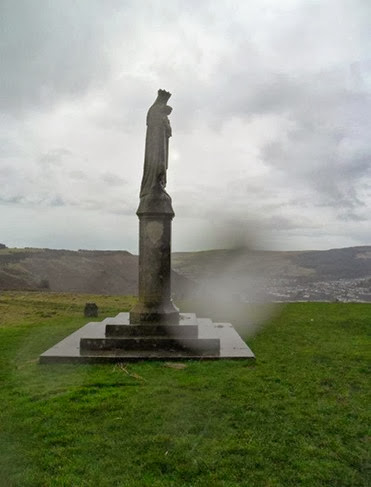 Our Lady watches over the Valleys
Our Lady watches over the Valleys
And the journey was far from wasted in other ways too, for climbing to the top of the hill again, I was so struck by just how incredibly beautiful and powerful – despite the human blight and the rain – the Rhondda is, that I burst into song, and what song could it be other than that favourite hymn of mine, ‘Guide me, O thou great Redeemer’, or, as it is known in Welsh, ‘Cwm Rhondda’, the second verse being particularly apt after drinking from a holy well:
Open thou the crystal fountain
Whence the healing stream shall flow;
Let the fiery, cloudy pillar
Lead me all my journey through:
Strong deliverer, strong deliverer
Be thou still my strength and shield.
Be thou still my strength and shield.
I climbed down the other side into the town of Ystrad in Rhondda Fawr and then took a train to Pontypridd where I changed for Merthyr Tydfil. The town actually has very ancient Christian connections: ‘Merthyr’ is the Welsh rendering of ‘martyr’ and Tydfil was an early saint, a princess who was captured and murdered for her beliefs around 480, but today nothing remains of that lady for the original village of Merthyr Tydfil was transformed during the 19th century, the shock city of the Welsh Industrial Revolution, Ironopolis, the largest population centre in the country with around fifty thousand souls at a time when Cardiff boasted less than ten thousand. And the reason for that rapid transformation were a series of enormous ironworks, most notably the gigantic Cyfarthfa complex. They are all now closed, but it was to their memory that I paid homage, trudging through the rain to Cyfarthfa Castle, once the home of the tyrannical William Crawshay II, ironmaster of the Cyfarthfa Works, who looked out from his faux fortress over his hellish realm of furnaces lighting up the night sky with their flames.
That was then; today the furnaces have been replaced with retail parks and warehousing whilst Cyfarthfa Castle is the town’s museum. I wandered through the exhibits, particularly the ones dealing with the town’s many socialist struggles, and wondered. The anger was understandable and genuine, and one should never let an oppressor, be they an ironmaster or an Iron Lady, just walk all over you, but how best to do so whilst still following Christ’s commandments to turn the other cheek and love thy enemy? Perhaps the key is to never let your anger become the dominant motive; retain your sense of justice, fight for what is right, but at all times, let love prevail.
Which is easier said than done.
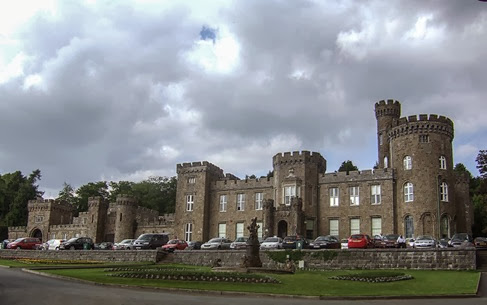 Cyfarthfa Castle with a suitably evil sky
Cyfarthfa Castle with a suitably evil sky
I used the last day of my Rail Rover to take a different route home, via Newport, Abergavenny, Hereford and Ludlow before rejoining my route out at Craven Arms, another of Britain’s more scenic rail trips. At Hereford I broke the journey to make my last pilgrimage stop and draw to a close my sacred journey: Hereford Cathedral.
Hereford Cathedral, like St. David’s, is blessed in the fact that it has a Dean who actively promotes pilgrimage. As a result, in recent years much has been done to improve and restore those sites in the building connected with pilgrimage.
Foremost amongst them is the Shrine of St. Thomas of Hereford. Born in 1218, Thomas Cantilupe became Bishop of Hereford and was much loved by the populace. After his death reports of miracles started flooding in and so, after an extensive investigation by the Vatican, he was eventually declared a saint and the pilgrims started to come in droves, both the English and the Welsh, so that for a time Hereford vied with that other shrine of St. Thomas, St. Thomas à Becket at Canterbury in popularity. However, there are two other “saints” associated with the cathedral: St. Ethelbert the Martyr, a Saxon boy king who was martyred in 794 and Thomas Traherne who was a simple parish priest who lived in the 17th century and who wrote prose and poetry in praise of God and His Creation.
To be fair, I came to these stories as a stranger; at present God is calling me to focus on the early years of His Church in Britain and whilst Ethelbert is of that era, he is too far geographically removed from the saints of Mercia for me to have encountered him before.
Therefore, Hereford was good for me; good as a reminder of the many ages of the Church – she is not just 6th and 7th century alone – and of the many ways in which Christians are called. Good too that I was back in England, the bearer of a very different form and tradition of Christianity compared with the rugged earthiness of Celtic Wales, this was the green and pleasant land which I’d walked through at Glastonbury and Walsingham. Most of all though, what heartened me was the conscious effort made by the cathedral authorities to promote pilgrimage and veneration of the saints. And pride of place amongst those efforts was St. Thomas’ tomb, freshly restored, resplendent in red, blue and gold, some of the relics returned by the local Roman Catholics, four candles burning bright, one at each corner. Here was a sight from the glory of mediaeval Christendom and it was an honour to pray before it.
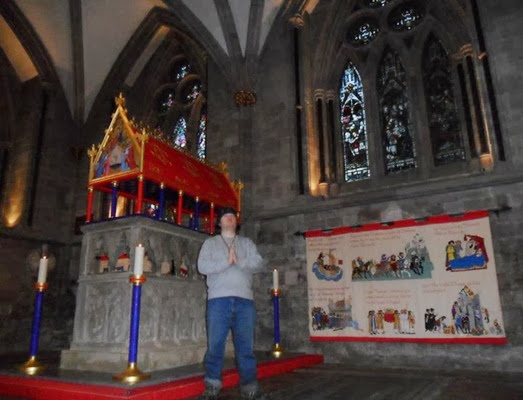 At the Shrine of St. Thomas of Hereford
At the Shrine of St. Thomas of Hereford
St. Ethelbert too has a restored and beautiful shrine, although it is very different. The location of the original shrine is not known for sure, but close to where it is thought to have been, there is a memorial, beautifully worked in the same red, blue and gold as St. Thomas’ Shrine, with twelve panels depicting scenes from his life wrapped around a pillar and that was my next port-of-call.
St. Ethelbert poses the modern day believer, particularly a left-leaning one such as me, with a serious problem. Of course, many saints challenge us, from St. Paul to St. Justinian we may question some of their attitudes and actions which seem perhaps a little offensive to our post-modern ethics, if not plain weird. My issues with St. Ethelbert however, did not fall into that category; instead, when I stood by his shrine, I found myself asking “Why?” Why on earth was this guy ever considered for sainthood?
A brief rundown of Ethelbert’s life goes as follows: He is born into the East Anglian royal family and at the tender age of fourteen he is crowned king. Soon afterwards he has to journey from his capital at Bury St. Edmunds to Mercia in order to marry King Offa’s daughter, Ælfrytha, (King Offa was the man with the power in those days). En route he has a vision – we’re not told of what, but one assumes it is religious – but upon arrival his political rivals begin their machinations and whispering campaign, culminating in them murdering him, chopping off his head at Marden near to Hereford.
And that’s it! No teaching, no miracles, no healing, nothing whatsoever, only a young puppet king who gets murdered as part of some Saxon power struggle. A sad tale perhaps, a man to pity, definitely, but a saint?
In fact though, I’d encountered this before. Whilst researching the Saxon saints of Mercia I’d come across St. Wystan at Repton, a near contemporary of Ethelbert, grandson of the King of Wessex who’d been murdered by the man who usurped his granddad’s throne, (one assumes, so that he couldn’t usurp it back). However Wystan, like Ethelbert, seems to have been made a saint more for events after his life rather than during it. The panels around his shrine show that after his murder, Ethelbert’s body was being taken to Hereford on an ox-cart when the head fell off the cart and a blind man stumbled upon it, picked it up and miraculously regained his sight. This was obviously a sign of God’s blessing on the young “martyr” and after that the miracles came thick and fast, (as too was the case with Wystan half a century later), and so he was sanctified even if no one was quite sure why God had blessed him so much.
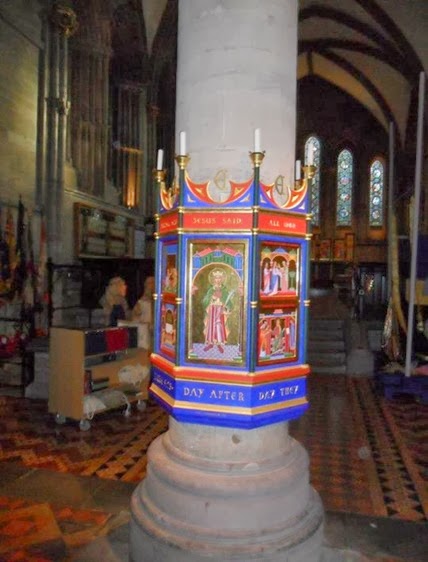 The Shrine of St. Ethelbert the Martyr
The Shrine of St. Ethelbert the Martyr
Hereford’s third “saint”, Thomas Traherne gives us the opposite problem to St. Ethelbert. He was never officially made a saint, but when remembering him we are compelled to ask why as he was as near to one as there has been since the Reformation. He is also honoured by the cathedral authorities in a series of stained-glass windows in a side chapel. True, their design was not to my taste; I found them to be too wishy-washy and vague, a stained-glass attempt at impressionism, but nonetheless, the thought was there and again I was heartened that, after around five hundred years of denial, the realisation that those who brought the Faith of Christ to our shores and then nurtured it throughout the centuries should be honoured, is being placed at the forefront of cathedral priorities.
And that is important. A nation that forgets its history is a nation that is condemned to repeat its mistakes as Churchill once said, and the same goes for religions too. We have forgotten the long, twisting, sometimes tortuous, sometimes smooth road that brought Christianity to our land and into our hearts and helped God establish Himself there. And I believe that in that forgetting there lies one of the reasons as to why the Church is failing to retain those hearts today. Cut off from the saints who trod our mountains green and pleasant pastures, we have become in some ways cut off from the God who inspired them. This pilgrimage helped me to reconnect one of those severed ties, to chip away a little at the dogma of Sola Scriptura and to get closer to Christ. I left the cathedral and re-entered the winter sunlight, walking down the main street back to the station.
And on the way I came across someone I knew. “Hello!” I said to the Hare Krishna guy from Cardiff. “You’re here as well?”
“Erm, yes,” he replied, brandishing his Bhagavad-Gita, as surprised to see me as I was to see him. “Today Hereford, tomorrow Cheltenham.”
I smiled, recognising a fellow pilgrim, albeit one who follows a path that I am sure I shall never fully comprehend. “Keep it up, son,” I said, shaking his hand, before heading off to the station.
Ibis Hotel, Wellingborough
September 2013
Next pilgrimage: Across the Sound
[1] ‘Christ in Majesty’ by Jacob Epstein
[2] Also known as Devereux, Dubric, Dubricus, Dyffryg and Dyfrig.
[3] St. Mary’s Well. ‘Mair’ is the Welsh rendering of ‘Mary’ although when preceded by the prefix ‘Llan’, (‘church’ or literally, ‘enclosure’), the ‘M’ morphs into an ‘F’, hence the hundreds of places across Wales named ‘Llanfair’.
[4] From ‘Jesus Christ’ by Woody Guthrie (1940)

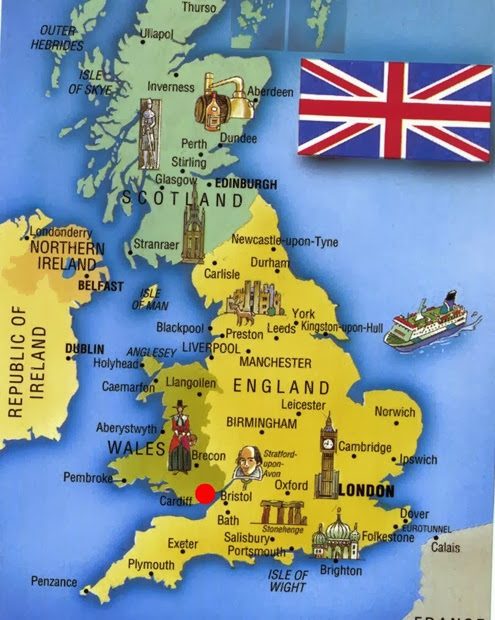

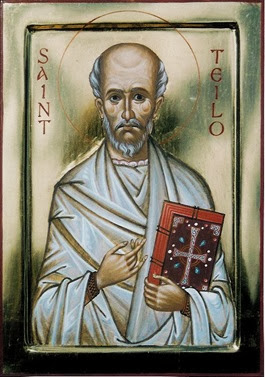
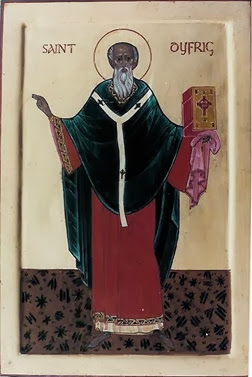
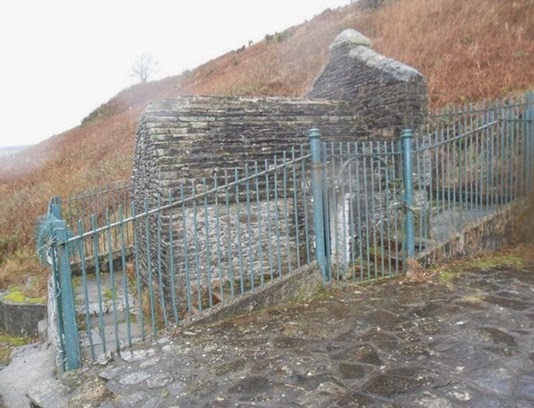
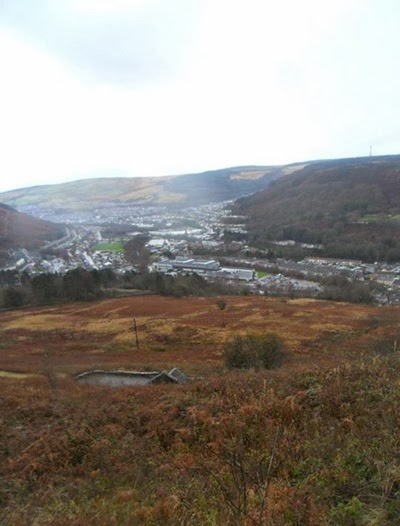
No comments:
Post a Comment